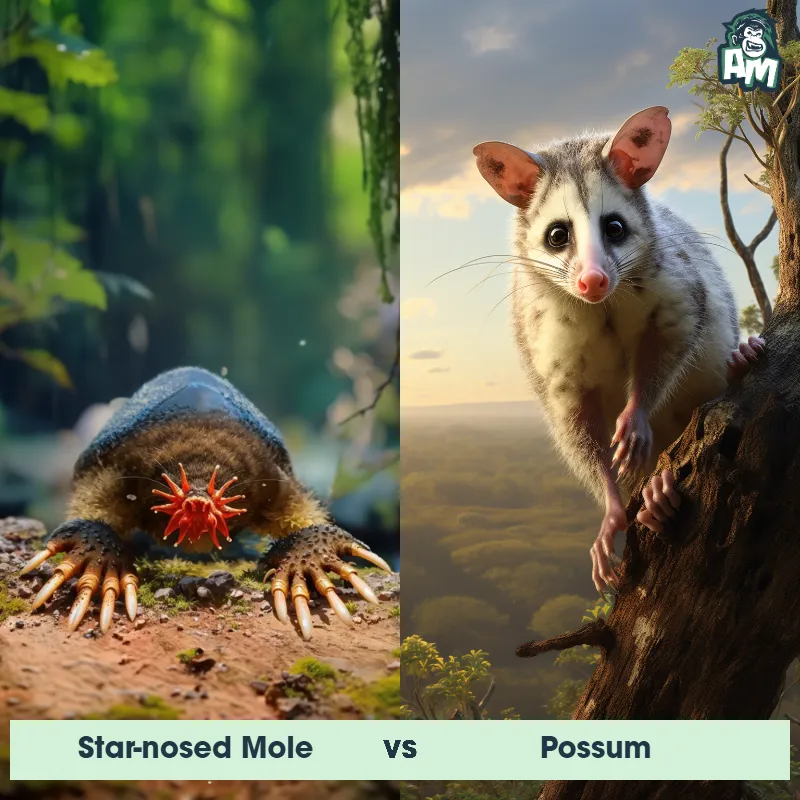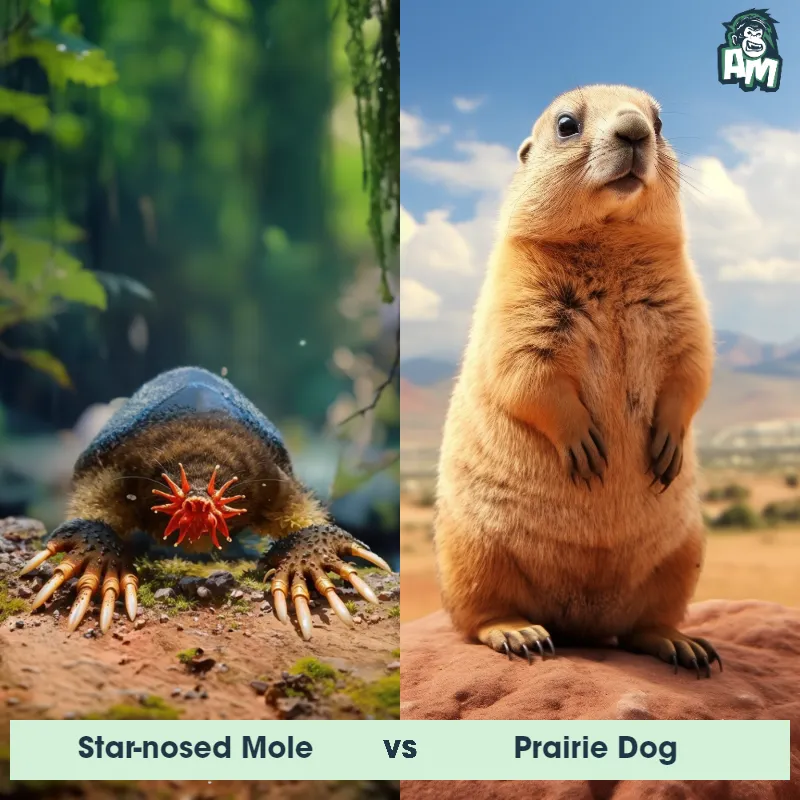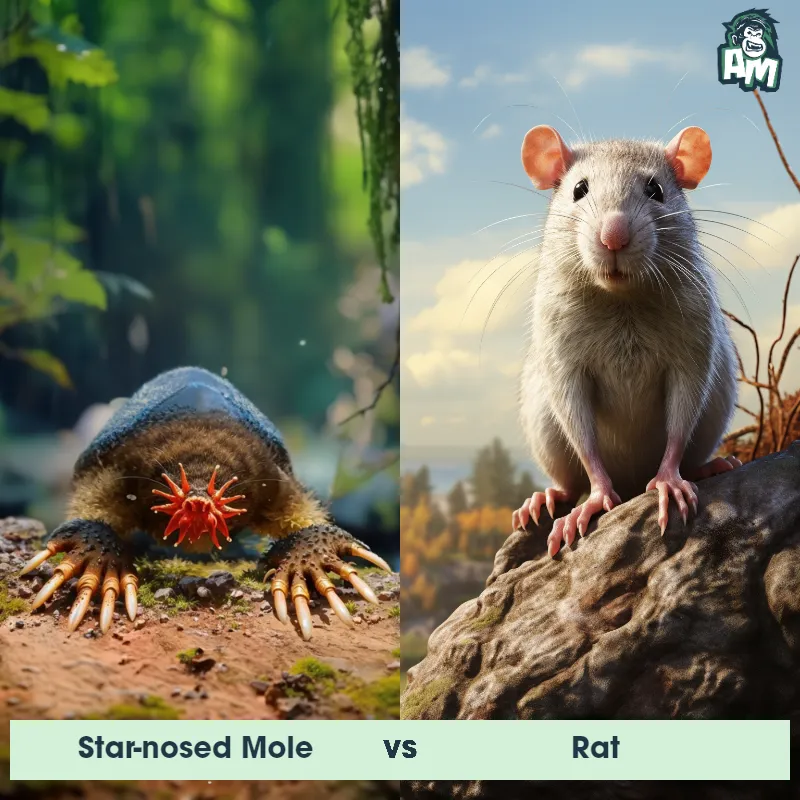The Star-Nosed Mole
The Star-Nosed Mole, scientifically known as Condylura cristata, is a small mammal found in the wetlands of eastern North America. It gets its name from the unique star-shaped appendage on its snout, which is incredibly sensitive and contains 22 tentacles. With soft velvety fur, the mole has a cylindrical body and short limbs well-suited for digging. It has poor eyesight and spends most of its time underground, foraging for food like insects, worms, and small amphibians. The Star-Nosed Mole can also swim adeptly, using its large webbed feet and paddle-like tail to navigate in water.

| Star-Nosed Mole | |
|---|---|
| Size | 6-8 inches (15-20 cm) |
| Weight | 1-2 ounces (30-60 grams) |
| Speed | 3 mph (4.8 km/h) |
| Key Strength | Speed and agility |
| Biggest Weakness | Lack of physical strength |
| Scientific Name | Condylura cristata |
| Family | Talpidae |
| Habitat | Wetlands |
| Geography | Eastern North America |
| Diet | Insects, worms, and small invertebrates |
| Lifespan | 4 years - 6 years |

The Star-Nosed Mole
The Star-Nosed Mole, scientifically known as Condylura cristata, is a small mammal found in the wetlands of eastern North America. It gets its name from the unique star-shaped appendage on its snout, which is incredibly sensitive and contains 22 tentacles. With soft velvety fur, the mole has a cylindrical body and short limbs well-suited for digging. It has poor eyesight and spends most of its time underground, foraging for food like insects, worms, and small amphibians. The Star-Nosed Mole can also swim adeptly, using its large webbed feet and paddle-like tail to navigate in water.
Fun Fact: The Star-Nosed Mole is known to be one of the fastest foragers in the animal kingdom, capable of capturing and consuming prey in as little as 230 milliseconds, making it almost too quick for the human eye to track.
| Star-Nosed Mole | |
|---|---|
| Size | 6-8 inches (15-20 cm) |
| Weight | 1-2 ounces (30-60 grams) |
| Speed | 3 mph (4.8 km/h) |
| Key Strength | Speed and agility |
| Biggest Weakness | Lack of physical strength |
| Scientific Name | Condylura cristata |
| Family | Talpidae |
| Habitat | Wetlands |
| Geography | Eastern North America |
| Diet | Insects, worms, and small invertebrates |
| Lifespan | 4 years - 6 years |
Star-Nosed Mole Matchups
We use AI to simulate matchups between the Star-Nosed Mole and other animals. Our simulation considers size, strength, and natural predatory behaviors to determine the most likely outcome.
Star-Nosed Mole: Diet, Predators, Aggression, and Defensive Behaviors
What do Star-Nosed Moles eat?
Star-Nosed Moles mainly feed on small invertebrates such as worms, insects, and larvae. They use their unique star-shaped nose to detect prey through touch rather than sight. This specialized nose is covered in sensitive tentacles that help them quickly find and consume their food in their underground habitat.
Do Star-Nosed Moles have any predators?
Yes, Star-Nosed Moles do have predators in the wild. Some of their main predators include owls, hawks, snakes, and larger mammals like weasels and foxes. Despite their small size, Star-Nosed Moles have adapted to minimize risk by being primarily nocturnal and spending most of their time underground.
Are Star-Nosed Moles aggressive?
Star-Nosed Moles are not typically aggressive towards other animals, including members of their own species. They are solitary creatures and spend most of their time digging tunnels and foraging for food. However, they may show aggression if they feel threatened or cornered.
Do Star-Nosed Moles fight with one another?
While Star-Nosed Moles are solitary animals, they may occasionally engage in aggressive behaviors with other moles, especially when competing for territory or mates. These interactions can involve pushing, shoving, and vocalizations to establish dominance.
How do Star-Nosed Moles defend themselves?
Star-Nosed Moles defend themselves primarily by using their speed and agility to escape from predators. They can quickly burrow into the ground to avoid danger, and their underground tunnels provide a safe retreat. In addition, their keen sense of touch and ability to navigate in dark, underground conditions help them avoid potential threats.
What is the biggest weakness of Star-Nosed Moles in a fight?
The biggest weakness of Star-Nosed Moles in a fight is their small size and fragile body structure. While their star-shaped nose and sharp claws help them in foraging and burrowing, they are not well-equipped for physical confrontations with larger predators or competitors. Their best defense mechanism is often to flee rather than engage in direct combat.
Fun Fact: The Star-Nosed Mole has an exceptional sense of touch, thanks to its star-shaped nose, which contains over 25,000 sensory receptors. This adaptation allows it to feel vibrations, detect movements, and determine the texture of objects in its surroundings with incredible precision.
Fun Fact: Despite its small size, the Star-Nosed Mole has an incredibly high metabolic rate, which means it needs to consume a substantial amount of food to sustain its energy levels. It can consume up to its own body weight in food every single day, making it a voracious eater.
















